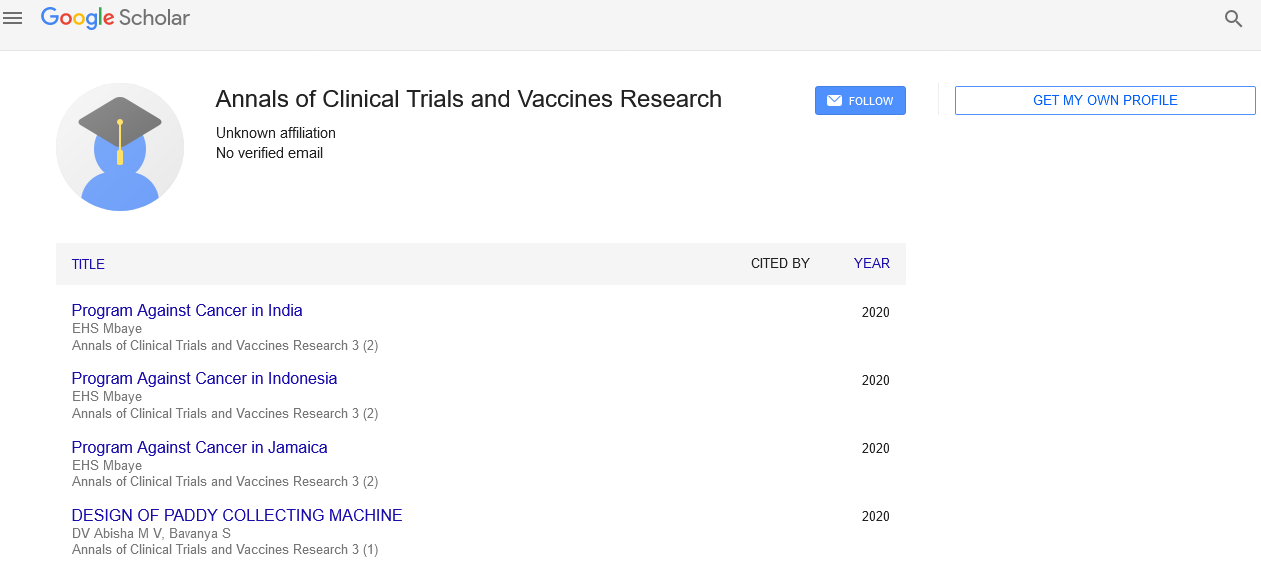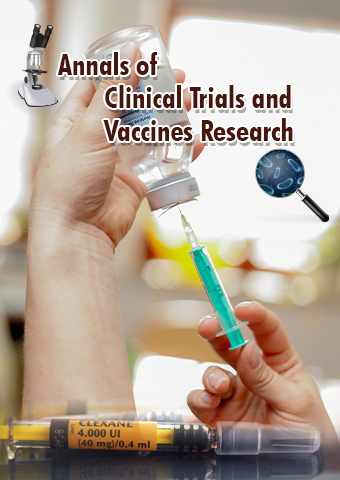Short Communication - Annals of Clinical Trials and Vaccines Research (2023) Volume 13, Issue 4
Advancing Medicine: Exciting Outcomes from Phase 3 Clinical Trials
Joan Jack*
Department of pharmacy, China, Peking University, China
Department of pharmacy, China, Peking University, China
E-mail: joanjack@gmail.com
Received: 01-August-2023, Manuscript No. actvr-23-108536; Editor assigned: 3-August-2023, PreQC No. actvr-23-108536 (PQ); Reviewed: 17-August-2023, QC No. actvr-23-108536; Revised: 22-August-2023, Manuscript No. actvr-23-108536 (R); Published: 28-August-2023; DOI: 10.37532/ ACTVR.2023.13(4).115-117
Abstract
The primary objective of Phase 3 clinical trials is to compare the effectiveness of the investigational intervention against existing treatments or placebos. Researchers measure various outcomes such as survival rates, disease progression, symptom relief, or quality of life improvements, depending on the therapeutic area and the nature of the condition being studied. By collecting extensive data on these endpoints, the trial aims to provide robust evidence of the drug’s efficacy and safety profile.
Introduction
To achieve meaningful results, the recruitment process in Phase 3 trials targets a diverse population, representative of the patients who will ultimately use the treatment if approved. Participants may have varying demographics, medical histories, and severity of the condition under investigation. This diversity ensures that the intervention’s effects are consistent across different patient groups.
The duration of Phase 3 trials varies based on the medical condition, treatment complexity, and expected outcomes. Some trials may last several months, while others can extend for several years. The extended observation period allows researchers to assess the intervention’s long-term effects, safety, and potential side effects that might not have surfaced in earlier phases. The conduct of Phase 3 trials adheres strictly to Good Clinical Practice (GCP) guidelines and protocols approved by regulatory agencies like the FDA in the United States or the European Medicines Agency (EMA) in Europe. These protocols outline the study design, patient eligibility criteria, dosing regimen, data collection methods, and statistical analyses [1,2].
Once the Phase 3 trial is completed, researchers thoroughly analyze the data collected from all participating sites. The data undergoes rigorous statistical scrutiny to ensure the results are reliable and reproducible. Statistical analyses help identify significant differences in treatment outcomes between the experimental group and the control group, shedding light on the intervention’s overall effectiveness and safety. The regulatory authorities carefully review the trial’s findings, assessing whether the benefits of the investigational treatment outweigh its potential risks. If the results demonstrate a substantial therapeutic effect with an acceptable safety profile, the company or sponsor can submit a New Drug Application (NDA) or a Marketing Authorization Application (MAA) to the regulatory agencies [3-5].
In many cases, successful Phase 3 trials lead to the approval of the new treatment. Regulatory approval allows the pharmaceutical company to market and distribute the drug for the specific medical condition it was tested for, providing patients with access to a potentially life-saving or life-improving therapy. However, it is essential to note that not all Phase 3 trials result in approval. Some trials may fail to demonstrate the desired efficacy or show unexpected safety concerns that outweigh the benefits. In such cases, the drug may not proceed to the market, and the researchers may need to reassess the intervention, explore additional research avenues, or modify the treatment approach.
Discussion
Phase 3 clinical trials are pivotal stages in drug development, aiming to confirm the safety and efficacy of an investigational treatment in a large and diverse patient population. Rigorous adherence to scientific protocols, ethical standards, and GCP guidelines ensures the reliability and integrity of the trial results. Successful Phase 3 trials can lead to regulatory approval and the introduction of new and improved treatments that have the potential to positively impact the lives of patients worldwide. Phase 3 clinical trials represent a crucial stage in the drug development process, where investigational treatments are rigorously evaluated to determine their safety, efficacy, and overall benefit-to-risk profile in a larger population. This phase follows Phase 1 and Phase 2 trials, which primarily focus on safety and dosing in small groups of volunteers and patients. Phase 3 trials involve a more extensive participant pool, often spanning across multiple sites and involving hundreds to thousands of individuals, depending on the disease’s prevalence and treatment’s intended use.
The primary objective of a Phase 3 clinical trial is to gather robust evidence of a treatment’s effectiveness and to further assess its safety profile in a diverse and representative patient population. This stage aims to confirm and extend the findings from the earlier phases, providing substantial evidence to support regulatory approval and eventual market access [6-8].
The design of Phase 3 trials is carefully planned to minimize bias and maximize the statistical significance of the results. Randomization and blinding techniques are commonly employed to ensure unbiased treatment assignment and outcome assessment. Patients are randomly allocated to different study arms, receiving either the investigational treatment, a comparator treatment, or a placebo, depending on the study’s design. Blinding ensures that neither the participants nor the investigators know which treatment each patient is receiving, reducing the risk of subjective influences on the study’s results. In Phase 3 trials, researchers collect a broad range of data, including clinical, laboratory, and sometimes patient-reported outcomes. These data help evaluate the treatment’s impact on disease progression, symptom relief, and overall quality of life. Additionally, researchers carefully monitor for any potential side effects or adverse events to comprehensively assess the treatment’s safety profile.
The duration of Phase 3 trials can vary, often lasting several months to several years, depending on the study’s goals and the nature of the disease being studied. Longer-term trials are particularly important for chronic conditions or diseases with slow progression to assess the treatment’s sustainability and long-lasting effects. Once the Phase 3 trial is completed, the data is meticulously analyzed, and the results are compared between the treatment groups. Statistical methods are applied to determine the significance of any observed differences in efficacy and safety outcomes. If the results are overwhelmingly positive, demonstrating clear superiority of the investigational treatment over the comparator or placebo, the data can support the application for regulatory approval.
Regulatory authorities, such as the U.S. Food and Drug Administration (FDA) and the European Medicines Agency (EMA), carefully review the Phase 3 trial data in the New Drug Application (NDA) or Marketing Authorization Application (MAA) to decide whether the treatment should be approved for commercial use. The submission includes comprehensive information on the treatment’s efficacy, safety, manufacturing processes, and proposed labeling. It is crucial to note that not all Phase 3 trials achieve their intended outcomes. Some trials may fail to demonstrate the expected efficacy or may reveal unforeseen safety concerns. In such cases, the drug may not proceed to regulatory approval, and further development might be halted. These outcomes, though disappointing, are valuable as they inform researchers about the limitations and potential risks of the treatment.
Moreover, the regulatory approval process also considers the risk-benefit balance of the treatment. For severe or life-threatening diseases with limited treatment options, a new drug with moderate efficacy and an acceptable safety profile may still receive approval if it offers a meaningful benefit to patients. After regulatory approval, Phase 4 trials, also known as post-marketing surveillance, may be conducted to monitor the treatment’s long-term safety and efficacy in realworld settings. These trials provide additional insights into the treatment’s performance, especially in larger and more diverse patient populations beyond the controlled environment of clinical trials [9,10].
Conclusion
In conclusion, Phase 3 clinical trials represent a pivotal stage in the drug development process, where investigational treatments undergo rigorous evaluation in large and diverse patient populations. These trials aim to confirm the treatment’s efficacy and safety, generating robust evidence to support regulatory approval and eventual market access. While successful Phase 3 trials can lead to new treatment options for patients, those that yield unexpected results or safety concerns contribute valuable information to the scientific community. Overall, Phase 3 trials play a vital role in advancing medical knowledge and improving patient care.
References
- Mannucci E, Giaccari A, Gallo M et al. Self-management in patients with type 2 diabetes: Group-based versus individual education a systematic review with meta-analysis of randomized trails. Nutr Metab Cardiovasc Dis. 32, 330-336 (2022).
- Emdin CA, Rahimi K, Callender T et al. Blood pressure lowering in type 2 diabetes: a systematic review and meta-analysis. JAMA. 313, 603-615 (2015).
- Davis N, Forbes B, Wylie-Rosett J et al. Nutritional strategies in type 2 diabetes mellitus. Mt Sinai J Med 76, 257-268 (2009).
- Feinman RD, Pogozelski WK, Astrup A et al. Dietary carbohydrate restriction as the first approach in diabetes management: critical review and evidence base. Nutrition. 31, 1-13 (2015).
- Schellenberg ES, Dryden DM, Vandermeer B et al. Lifestyle interventions for patients with and at risk for type 2 diabetes: a systematic review and meta-analysis. Annals of Internal Medicine. 159, 543-551 (2013).
- O'Gorman DJ, Krook A. Exercise and the treatment of diabetes and obesity. Med Clin N. 95, 953-969 (2011).
- Wild S, Roglic G, Green A et al. Global prevalence of diabetes: estimates for the year 2000 and projections for 2030. Diabetes Care. 27, 1047-53 (2004).
- Carulli L, Rondinella S, Lombardini S et al. Review article: diabetes, genetics and ethnicity. Aliment Pharmacol Ther. 22, 16-9 (2005).
- Abate N, Chandalia M. Ethnicity and type 2 diabetes: focus on Asian Indians. JDC. 15, 320-7 (2001).
- Dixon JB, le Roux CW, Rubino F et al. Bariatric surgery for type 2 diabetes. Lancet. 379, 2300-11 (2012).
Indexed at, Google Scholar, Crossref
Indexed at, Google Scholar, Crossref
Indexed at, Google Scholar, Crossref
Indexed at, Google Scholar, Crossref
Indexed at, Google Scholar, Crossref
Indexed at, Google Scholar, Crossref
Indexed at, Google Scholar, Crossref
Indexed at, Google Scholar, Crossref
Indexed at, Google Scholar, Crossref

